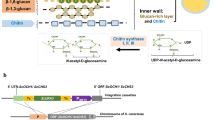Abstract
Objectives
Developing a Saccharomyces cerevisiae system for optimizing the expression of recombinant eukaryotic proteins.
Results
Two deletion mutants, which were hypersensitive to H2O2, were obtained by knocking out CTT1 and SOD2, respectively. The mutation rate of the mutants was up to over 4000 times of the spontaneous mutation rate when treated with H2O2. Endoglucanase Cel5A was used as a model enzyme to evaluate the system for improving the expression of the recombinant protein. Sixteen mutants of the RDKY3615 (ctt1∆) transformant and seven mutants of the RDKY3615 (sod2∆) transformant had significantly high Cel5A activity, while none mutants of the RDKY3615 transformant had significantly high enzyme activity.
Conclusion
The combination of deletion mutagenesis and H2O2 treatment greatly accelerate the generation of genetic variants and will be a useful tool in improving the heterologous expression in S. cerevisiae.





Similar content being viewed by others
References
Callanan MJ, Russell WM, Klaenhammer TR (2007) Modification of Lactobacillus beta-glucuronidase activity by random mutagenesis. Gene 389:122–127
Celik E, Calik P (2012) Production of recombinant proteins by yeast cells. Biotechnol Adv 30:1108–1118
de Jong B, Siewers V, Nielsen J (2012) Systems biology of yeast: enabling technology for development of cell factories for production of advanced biofuels. Curr Opin Biotech 23:624–630
Den Haan R, Rose SH, Lynd LR, van Zyl WH (2007) Hydrolysis and fermentation of amorphous cellulose by recombinant Saccharomyces cerevisiae. Metab Eng 9:87–94
Hong KK, Nielsen J (2012) Metabolic engineering of Saccharomyces cerevisiae: a key cell factory platform for future biorefineries. Cell Mol Life Sci 69:2671–2690
Hong J, Tamaki H, Yamamoto K, Kumagai H (2003) Cloning of a gene encoding thermostable cellobiohydrolase from Thermoascus aurantiacus and its expression in yeast. Appl Microbiol Biotechnol 63:42–50
Idiris A, Tohda H, Kumagai H, Takegawa K (2010) Engineering of protein secretion in yeast: strategies and impact on protein production. Appl Microbiol Biotechnol 86:403–417
Lee DH, O’Connor TR, Pfeifer GP (2002) Oxidative DNA damage induced by copper and hydrogen peroxide promotes CG→TT tandem mutations at methylated CpG dinucleotides in nucleotide excision repair-deficient cells. Nucleic Acids Res 30:3566–3573
Lu XY, Hirata H, Yamaji Y, Ugaki M, Namba S (2001) Random mutagenesis in a plant viral genome using a DNA repair-deficient mutator Escherichia coli strain. J Virol Methods 94:37–43
Lynd LR, Weimer PJ, van Zyl WH, Pretorius IS (2002) Microbial cellulose utilization: fundamentals and biotechnology. Microbiol Mol Biol Rev 66:506–577
Matano Y, Hasunuma T, Kondo A (2013) Simultaneous improvement of saccharification and ethanol production from crystalline cellulose by alleviation of irreversible adsorption of cellulase with a cell surface-engineered yeast strain. Appl Microbiol Biotechnol 97:2231–2237
Meinke A, Damude HG, Tomme P, Kwan E, Kilburn DG, Miller RC, Warren RAJ, Gilkes NR (1995) Enhancement of the endo-beta-1,4-glucanase activity of an exocellobiohydrolase by deletion of a surface loop. J Biol Chem 270:4383–4386
Moraes EC, Keyse SM, Tyrrell RM (1990) Mutagenesis by hydrogen peroxide treatment of mammalian cells—a molecular analysis. Carcinogenesis 11:283–293
Nakatani Y, Yamada R, Ogino C, Kondo A (2013) Synergetic effect of yeast cell-surface expression of cellulase and expansin-like protein on direct ethanol production from cellulose. Microb Cell Fact 12:66
Qin YQ, Wei XM, Liu XM, Wang TH, Qu YB (2008) Purification and characterization of recombinant endoglucanase of Trichoderma reesei expressed in Saccharomyces cerevisiae with higher glycosylation and stability. Protein Expr Purif 58:162–167
Teather RM, Wood PJ (1982) Use of congo red polysaccharide interactions in enumeration and characterization of cellulolytic bacteria from the bovine rumen. Appl Environ Microbiol 43:777–780
Unlu ES, Koc A (2007) Effects of deleting mitochondrial antioxidant genes on life span. Ann N Y Acad Sci 1100:505–509
Van Zyl JHD, Den Haan R, Van Zyl WH (2014) Over-expression of native Saccharomyces cerevisiae exocytic SNARE genes increased heterologous cellulase secretion. Appl Microbiol Biotechnol 98:5567–5578
Wieser R, Adam G, Wagner A, Schuller C, Marchler G, Ruis H, Krawiec Z, Bilinski T (1991) Heat shock factor-independent heat control of transcription of the CTT1 gene encoding the cytosolic catalase T of Saccharomyces cerevisiae. J Biol Chem 266:12406–12411
Wu GC, Wei LG, Liu WF, Lin JQ, Wang LS, Qu YB, Zhuang GQ (2010) Asn64-glycosylation affects Hypocrea jecorina (syn. Trichoderma reesei) cellobiohydrolase Cel7A activity expressed in Pichia pastoris. World J Microb Biotechnol 26:323–328
Yang HJ, Liu C, Zou SL, Ma YY, Hong JF, Zhang MH (2014) Improving bgl1 gene expression in Saccharomyces cerevisiae through meiosis in an isogenic triploid. Biotechnol Lett 36:1279–1285
Yu SS, Qin W, Zhuang GQ, Zhang XE, Chen GJ, Liu WF (2009) Monitoring oxidative stress and DNA damage Induced by heavy metals in yeast expressing a redox-sensitive green fluorescent protein. Curr Microbiol 58:504–510
Acknowledgement
This work was supported by the National Basic Research Program (2003CB716000 and 2010CB630902), the National Science Found (Nos. 30370036 and 30670039), the National Key Technology R&D Program (2011BAC02B04), the National High Technology Research and Development Program (2007AA05Z455) of China and the Fund of Glycosylation Research Group in Shandong University. We thank Prof. Tianhong Wang for kindly providing the pUCmT-Cel5A vector.
Supporting information
Supplementary Table 1—Strains and plasmids used in this study.
Supplementary Table 2—PCR primers used in this study.
Supplementary Figure 1—Screen of the mutants for high Cel5A activity on activity indicator plate. Each colony was formed from a single cell. CMC around the colonies was hydrolyzed by Cel5A secreted by the colonies. The size of the hydro-halo represented the secreted endoglucanase activity of the colony.
Author information
Authors and Affiliations
Corresponding author
Electronic supplementary material
Below is the link to the electronic supplementary material.
Rights and permissions
About this article
Cite this article
Wu, G., Sun, J., Yu, S. et al. Improved activity of the Cel5A endoglucanase in Saccharomyces cerevisiae deletion mutants defective in oxidative stress defense mechanisms. Biotechnol Lett 37, 1081–1089 (2015). https://doi.org/10.1007/s10529-015-1771-y
Received:
Accepted:
Published:
Issue Date:
DOI: https://doi.org/10.1007/s10529-015-1771-y




